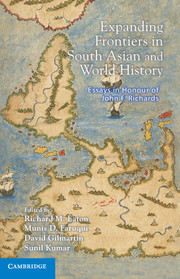Book contents
- Frontmatter
- Contents
- List of Contributors
- Foreword
- Introduction
- 1 At Empire's End: The Nizam, Hyderabad and Eighteenth-century India
- 2 The Ignored Elites: Turks, Mongols and a Persian Secretarial Class in the Early Delhi Sultanate
- 3 ‘Silk Road, Cotton Road or … Indo-Chinese Trade in Pre-European Times’
- 4 The Political Economy of Opium Smuggling in Early Nineteenth Century India: Leakage or Resistance?
- 5 Opium and the Company: Maritime Trade and Imperial Finances on Java, 1684–1796
- 6 The Mughals, the Sufi Shaikhs and the Formation of the Akbari Dispensation
- 7 Notes on Political Thought in Medieval and Early Modern South India
- 8 Becoming Turk the Rajput Way: Conversion and Identity in an Indian Warrior Narrative
- 9 Nature and Nurture on Imperial China's Frontiers
- 10 The Frontiers of Memory: What the Marathas Remembered of Vijayanagara
- 11 ‘Kiss My Foot,’ Said the King: Firearms, Diplomacy and the Battle for Raichur, 1520
- 12 Frontiers of Family Life: Early Modern Atlantic and Indian Ocean Worlds
- 13 Chinese Revenue Farms and Borders in Southeast Asia
- Publications
- Index
5 - Opium and the Company: Maritime Trade and Imperial Finances on Java, 1684–1796
Published online by Cambridge University Press: 05 January 2014
- Frontmatter
- Contents
- List of Contributors
- Foreword
- Introduction
- 1 At Empire's End: The Nizam, Hyderabad and Eighteenth-century India
- 2 The Ignored Elites: Turks, Mongols and a Persian Secretarial Class in the Early Delhi Sultanate
- 3 ‘Silk Road, Cotton Road or … Indo-Chinese Trade in Pre-European Times’
- 4 The Political Economy of Opium Smuggling in Early Nineteenth Century India: Leakage or Resistance?
- 5 Opium and the Company: Maritime Trade and Imperial Finances on Java, 1684–1796
- 6 The Mughals, the Sufi Shaikhs and the Formation of the Akbari Dispensation
- 7 Notes on Political Thought in Medieval and Early Modern South India
- 8 Becoming Turk the Rajput Way: Conversion and Identity in an Indian Warrior Narrative
- 9 Nature and Nurture on Imperial China's Frontiers
- 10 The Frontiers of Memory: What the Marathas Remembered of Vijayanagara
- 11 ‘Kiss My Foot,’ Said the King: Firearms, Diplomacy and the Battle for Raichur, 1520
- 12 Frontiers of Family Life: Early Modern Atlantic and Indian Ocean Worlds
- 13 Chinese Revenue Farms and Borders in Southeast Asia
- Publications
- Index
Summary
INTRODUCTION
The history of Bengal opium and the Dutch East India Company (the Verenigde Oostindische Compagnie, the VOC or the Company) over the long eighteenth century (or from 1684–1796) is examined in this essay. From the Company's perspective, it was a period that may be characterized as the end of the age of commerce, metamorphosis from a commercial organization deriving its profits from maritime trade to the exploitation and colonial administration of agricultural production and mineral resources and revenues from tax farming, and of decline. The Company was not omnipotent. By 1684, the Company may be characterized as being more pragmatic than bellicose in its commercial inter-relationships with other states and Asian and European merchants. By 1796, with its maritime trading activities long surpassed in Asia and Europe by European competitors, especially the English East India Company (EIC), the VOC had to declare bankruptcy.
A series of specific questions are raised and answered in the first and second sections of this essay: how important was Bengal opium in the Company's commercial and imperial activities? What was the relationship of the Company's maritime trade in opium between Bengal and Batavia with the non-Company maritime trade of Asian and other European merchants at Batavia? And, specifically, how important was the revenue from the sale of Bengal opium at Batavia in the Company's local and imperial finances? The Company's prodigious records were examined to find answers to those questions. The empirical data that was found and examined was subjected to a series of traditional quantitative economic—supply or commodity chain, trend and transactional—analyses.
- Type
- Chapter
- Information
- Expanding Frontiers in South Asian and World HistoryEssays in Honour of John F. Richards, pp. 104 - 123Publisher: Cambridge University PressPrint publication year: 2013



